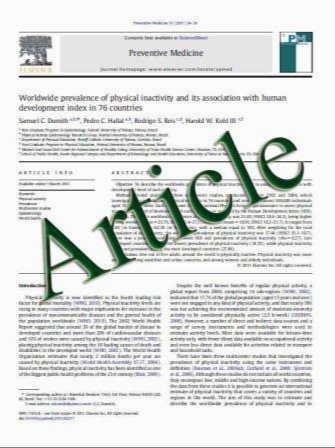Contribution of comorbidities to functional impairment is higher in heart failure with preserved than with reduced ejection fraction
- نوع فایل : کتاب
- زبان : انگلیسی
- مؤلف : Frank Edelmann Raoul Stahrenberg Go¨tz Gelbrich Kathleen Durstewitz Christiane E. Angermann Hans-Dirk Du¨ngen Thomas Scheffold Christian
- چاپ و سال / کشور: 2011
Description
Background Comorbidities negatively affect prognosis more strongly in heart failure with preserved (HFpEF) than with reduced (HFrEF) ejection fraction. Their comparative impact on physical impairment in HFpEF and HFrEF has not been evaluated so far. Methods and results The frequency of 12 comorbidities and their impact on NYHA class and SF-36 physical functioning score (SF-36 PF) were evaluated in 1,294 patientswith HFpEF and 2,785 with HFrEF. HFpEF patients had lower NYHA class (2.0 ± 0.6 vs. 2.4 ± 0.6, p\0.001) and higher SF-36 PF score (54.4 ± 28.3 vs. 54.4 ± 27.7, p\0.001). All comorbidities were significantly (p\0.05) more frequent in HFrEF, except hypertension and obesity, which were more frequent inHFpEF (p\0.001). Adjusting for age and gender, COPD, anemia, hyperuricemia, atrial fibrillation, renal dysfunction, cerebrovascular disease and diabetes had a similar (p for interaction [0.05) negative effect in both groups. Obesity, coronary artery disease and peripheral arterial occlusive disease exerted a significantly (p\0.05) more adverse effect in HFpEF, while hypertension and hyperlipidemia were associated with fewer (p\0.05) symptoms in HFrEF only. The total impact of comorbidities on NYHA (AUC for prediction of NYHA III/IV vs. I/II) and SF-36 PF (r2) in multivariate analyses was approximately 1.5-fold higher in HFpEF, and also much stronger than the impact of a 10% decrease in ejection fraction in HFrEF or a 5 mm decrease in left ventricular end-diastolic diameter in HFpEF. Conclusion The impact of comorbidities on physical impairment is higher in HFpEF than in HFrEF. This should be considered in the differential diagnosis and in the treatment of patients with HFpEF.
Clin Res Cardiol Received: 2 November 2010 / Accepted: 7 March 2011


